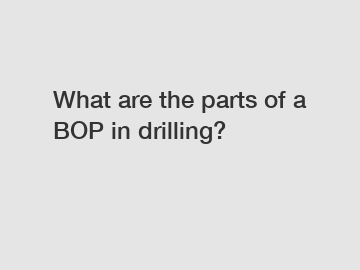What are the parts of a BOP in drilling?
What are the parts of a BOP in drilling?
BOP, which stands for Blowout Preventer, is a critical piece of equipment used in drilling operations to prevent blowouts and control well pressure. It is a robust and complex device that is specifically designed to seal and control the flow of fluids during drilling and well intervention processes. Understanding the different parts of a BOP is crucial for a successful and safe drilling operation. In this article, we will explore the main components of a BOP and their functions.
1. Annular BOP.

The annular BOP is the primary sealing component of a BOP stack. It consists of a flexible elastomeric seal known as the packing element that forms a complete seal around the drill pipe or casing, preventing the uncontrolled release of fluids. The packing element can be either shear or pipe rams, which are used for additional sealing in certain situations. The annular BOP can operate either hydraulically, mechanically, or by using a combination of both.
2. Ram BOP.
Also known as shear rams or pipe rams, the ram BOP serves as an additional layer of protection against blowouts. It consists of two halves that can close around the drill pipe or casing, forming a tight seal. Ram BOPs are designed to shear through and seal off the drill pipe or casing in case of an emergency, providing a reliable barrier to prevent the escape of well fluids.
3. Control System.
The control system is the brain behind the operation of a BOP. It includes hydraulic control units and accumulators that supply hydraulic pressure to open, close, and control the different sealing components. The control system also monitors and controls the various functions of the BOP stack, providing vital information to the drilling crew to ensure a safe and efficient operation.
4. Hydraulics.
Hydraulics play a crucial role in the operation of a BOP. They transfer hydraulic pressure from the control system to the BOP stack, allowing the movement of various components and the activation of the sealing elements. It also provides the necessary force to shear through the drill pipe or casing in an emergency. Proper maintenance and monitoring of the hydraulic system are essential to ensure optimal performance of the BOP.
5. Choke and Kill Manifold.
The choke and kill manifold is a vital component of the BOP stack. It controls the flow of fluids from the well and provides a means to choke or kill the well in case of an emergency. The choke manifold regulates the pressure and flow rate of the well fluids, while the kill manifold is used to pump heavy drilling fluids or specialized fluids into the well to control pressures and counterbalance any excessive formation pressures.
In conclusion, a BOP is a complex assembly of various components that work together to prevent blowouts and control well pressure during drilling operations. Each part has a specific function, whether it is sealing the well, controlling hydraulic pressure, or regulating flow rates. Understanding the different parts of a BOP and their functions is crucial for the safe and successful execution of drilling activities.
For further inquiries or information, please do not hesitate to contact us.
If you want to learn more, please visit our website 3000psi Annular BOP, drilling bop manufacturers, 18 3/4”Annular BOP.


